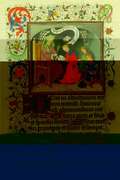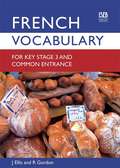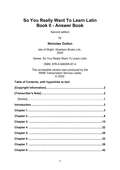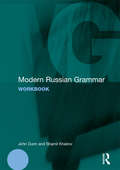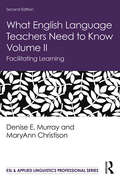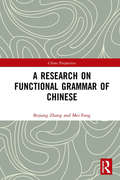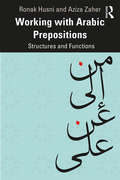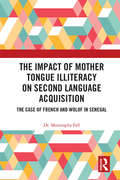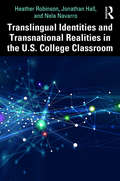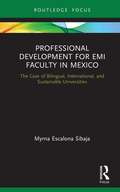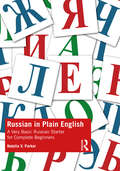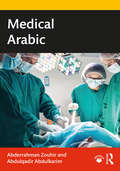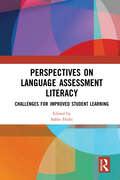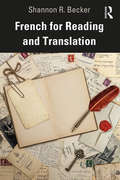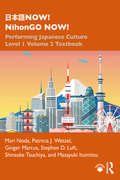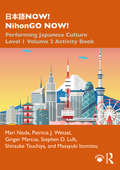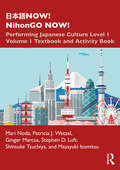- Table View
- List View
English School Exercises, 1420-1530 (Studies And Texts #181 (PDF))
by Nicholas Orme Pontifical Institute of Mediaeval Studies Staff"In his latest of many distinguished contributions to the history of medieval education, Nicholas Orme edits and translates into modern English twelve sets of the translation exercises known as 'latins.' Devised to teach Anglophone boys the basics of Latin composition, these hundreds of short texts do much more than illustrate pedagogical methods that continued in use even as medieval gave way to humanist Latin in the schools. They provide fascinating glimpses of fifteenth- and early sixteenth-century English popular culture and everyday life as viewed by adolescents aspiring to worldly success while enduring outbreaks of plague, bad meals, and especially the master's harsh discipline. In his introductions and annotations, Orme draws on his unsurpassed knowledge of English grammar schools to contextualize and enhance these vivid images. Historians of education may be the principal audience for the book, but anyone interested in medieval language, customs, and institutions will consult it with pleasure and profit." -Martin Camargo, University of Illinois at Urbana-Champaign
French Vocabulary for Key Stage 3 and Common Entrance (PDF)
by John Ellis Richard GordonCovers various topics in the 13+ French syllabus with nouns, verbs, adjectives and other words. This book includes a selection of short dictees at the end of each topic.
So You Really Want To Learn Latin Book II Answer Book (So You Really Want To Learn Latin)
by N.R.R. OultonModern Russian Grammar Workbook (Modern Grammar Workbooks)
by John Dunn Shamil KhairovModern Russian Grammar Workbook is an innovative book of exercises and language tasks for all learners of Russian. The book is divided into two parts. Section 1 provides exercises based on essential grammatical structures. Section 2 practises everyday functions such as making introductions, apologizing and expressing needs. A comprehensive answer key at the back of the book enables students to check on their progress. Main features include: exercises graded according to level of difficulty cross referencing to the related Modern Russian Grammar topical exercises which develop students’ vocabulary base. The Modern Russian Grammar Workbook is ideal for all learners of Russian, from beginner to intermediate and advanced students. It can be used both independently and alongside the Modern Russian Grammar: A Practical Guide, also published by Routledge. John Dunn is Honorary Research Fellow and Shamil Khairov is Lecturer in Russian, both at the School of Modern Languages and Cultures, University of Glasgow.
What English Language Teachers Need to Know Volume II: Facilitating Learning (ESL & Applied Linguistics Professional Series)
by Denise E. Murray MaryAnn ChristisonDesigned for pre-service teachers and teachers new to the field of ELT, Volume II of the What English Language Teachers Need to Know set covers the three main facets of teaching: planning, instructing, and assessing. Updated with new research throughout, the focus throughout is on outcomes, that is, student learning. The texts work for teachers across different contexts; different levels, and different learning purposes. The Second Edition has expanded to address corpus-based data, new technologies, and a wider range of contexts.
What English Language Teachers Need to Know Volume II: Facilitating Learning (ESL & Applied Linguistics Professional Series)
by Denise E. Murray MaryAnn ChristisonDesigned for pre-service teachers and teachers new to the field of ELT, Volume II of the What English Language Teachers Need to Know set covers the three main facets of teaching: planning, instructing, and assessing. Updated with new research throughout, the focus throughout is on outcomes, that is, student learning. The texts work for teachers across different contexts; different levels, and different learning purposes. The Second Edition has expanded to address corpus-based data, new technologies, and a wider range of contexts.
A Research on Functional Grammar of Chinese (Chinese Linguistics)
by Bojiang Zhang Mei FangThe functional perspective on Chinese syntax has yielded various new achievements since its introduction to Chinese linguistics in the 1980s. This two-volume book is one of the earliest and most influential works to study the Chinese language using functional grammar. With local Beijing vernacular (Pekingese) as a basis, the information structure and focus structure of the Chinese language are systematically examined. By using written works and recordings from Beijingers, the authors discuss topics such as the relationship between word order and focus, and the distinction between normal focus and contrastive focus. In addition, the authors also subject the reference and grammatical categories of the Chinese language to a functional scrutiny while discussion of word classes and their functions creatively combines modern linguistic theories and traditional Chinese linguistic theories. This book will be of interest to students and scholars of Chinese linguistics and linguistics in general.
Working with Arabic Prepositions: Structures and Functions
by Ronak Husni Aziza ZaherWorking with Arabic Prepositions: Structures and Functions is a reference book focusing on Arabic prepositions, their structure and usage. The system of Arabic prepositions is complex, and the textbook aims to assist students at the lower intermediate to advanced level understand it in an accessible way. This is an area in which students can experience great difficulty, and the aim of this book is to explain clearly the structures and functions of Arabic prepositions and their usage in Modern Standard Arabic and media Arabic. Drills and exercises are provided to enable readers to practice what they have learned in the chapters. This book will be an ideal source of information for undergraduate students studying Arabic, as well as graduate studies and additional courses in the major dialect areas, and a very useful resource for teachers of Arabic as a foreign language.
The Impact of Mother Tongue Illiteracy on Second Language Acquisition: The Case of French and Wolof in Senegal (Routledge Research in Language Education)
by Moustapha FallThis text illustrates the crucial role of the mother tongue literacy in second language acquisition by presenting findings from a comparative study conducted in primary schools in Senegal. In addition, the volume provides an in-depth look at the linguistic history of Senegal before, during, and after French colonialism. The Impact of Mother Tongue Illiteracy on Second Language Acquisition discusses the socio-linguistic landscape and ethnolinguistic composition of Senegal and its effect on the second language acquisition. An in-depth analysis of children’s phonological awareness, decoding, and reading comprehension in French reveals significant disparities in the literacy skills of Wolof children who have been exposed to Arabic and Qur’anic texts prior to schooling, and those who have not. In doing so, the text explores the impacts of post-colonial language policies in Africa, highlights the pedagogical consequences of mother tongue illiteracy, and questions the use of French as the only language of instruction in Senegalese schools. This detailed research text will of great interest and use to graduate and postgraduate students, researchers, academics, professionals and policy makers in the field of Second Language Acquisition, Multicultural Education, Applied Linguistics, French language education and, Language Policy and Planning.
The Impact of Mother Tongue Illiteracy on Second Language Acquisition: The Case of French and Wolof in Senegal (Routledge Research in Language Education)
by Moustapha FallThis text illustrates the crucial role of the mother tongue literacy in second language acquisition by presenting findings from a comparative study conducted in primary schools in Senegal. In addition, the volume provides an in-depth look at the linguistic history of Senegal before, during, and after French colonialism. The Impact of Mother Tongue Illiteracy on Second Language Acquisition discusses the socio-linguistic landscape and ethnolinguistic composition of Senegal and its effect on the second language acquisition. An in-depth analysis of children’s phonological awareness, decoding, and reading comprehension in French reveals significant disparities in the literacy skills of Wolof children who have been exposed to Arabic and Qur’anic texts prior to schooling, and those who have not. In doing so, the text explores the impacts of post-colonial language policies in Africa, highlights the pedagogical consequences of mother tongue illiteracy, and questions the use of French as the only language of instruction in Senegalese schools. This detailed research text will of great interest and use to graduate and postgraduate students, researchers, academics, professionals and policy makers in the field of Second Language Acquisition, Multicultural Education, Applied Linguistics, French language education and, Language Policy and Planning.
Translingual Identities and Transnational Realities in the U.S. College Classroom
by Heather Robinson Jonathan Hall Nela NavarroExploring the roles of students’ pluralistic linguistic and transnational identities at the university level, this book offers a novel approach to translanguaging by highlighting students’ perspectives, voices, and agency as integral to the subject. Providing an original reconsideration of the impact of translanguaging, this book examines both transnationality and translinguality as ubiquitous phenomena that affect students’ lives. Demonstrating that students are the experts of their own language practices, experiences, and identities, the authors argue that a proactive translingual pedagogy is more than an openness to students’ spontaneous language variations. Rather, this proactive approach requires students and instructors to think about students’ holistic communicative repertoire, and how it relates to their writing. Robinson, Hall, and Navarro address students’ complex negotiations and performative responses to the linguistic identities imposed upon them because of their skin color, educational background, perceived geographical origin, immigration status, and the many other cues used to "minoritize" them. Drawing on multiple disciplinary discourses of language and identity, and considering the translingual practices and transnational experiences of both U.S. resident and international students, this volume provides a nuanced analysis of students’ own perspectives and self-examinations of their complex identities. By introducing and addressing the voices and self-reflections of undergraduate and graduate students, the authors shine a light on translingual and transnational identities and positionalities in order to promote and implement inclusive and effective pedagogies. This book offers a unique yet essential perspective on translinguality and transnationality, and is relevant to instructors in writing and language classrooms; to administrators of writing programs and international student support programs; and to graduate students and scholars in language education, second language writing, applied linguistics, and literacy studies.
Translingual Identities and Transnational Realities in the U.S. College Classroom
by Heather Robinson Jonathan Hall Nela NavarroExploring the roles of students’ pluralistic linguistic and transnational identities at the university level, this book offers a novel approach to translanguaging by highlighting students’ perspectives, voices, and agency as integral to the subject. Providing an original reconsideration of the impact of translanguaging, this book examines both transnationality and translinguality as ubiquitous phenomena that affect students’ lives. Demonstrating that students are the experts of their own language practices, experiences, and identities, the authors argue that a proactive translingual pedagogy is more than an openness to students’ spontaneous language variations. Rather, this proactive approach requires students and instructors to think about students’ holistic communicative repertoire, and how it relates to their writing. Robinson, Hall, and Navarro address students’ complex negotiations and performative responses to the linguistic identities imposed upon them because of their skin color, educational background, perceived geographical origin, immigration status, and the many other cues used to "minoritize" them. Drawing on multiple disciplinary discourses of language and identity, and considering the translingual practices and transnational experiences of both U.S. resident and international students, this volume provides a nuanced analysis of students’ own perspectives and self-examinations of their complex identities. By introducing and addressing the voices and self-reflections of undergraduate and graduate students, the authors shine a light on translingual and transnational identities and positionalities in order to promote and implement inclusive and effective pedagogies. This book offers a unique yet essential perspective on translinguality and transnationality, and is relevant to instructors in writing and language classrooms; to administrators of writing programs and international student support programs; and to graduate students and scholars in language education, second language writing, applied linguistics, and literacy studies.
Professional Development for EMI Faculty in Mexico: The Case of Bilingual, International, and Sustainable Universities (Routledge Focus on English Medium Instruction in Higher Education)
by Myrna Escalona SibajaDespite Mexico’s implementation of a bilingual model in its tertiary education programmes, this book is the first contribution to knowledge regarding EMI in Mexico. The author introduces readers to the Mexican higher education context before providing detailed information regarding the technological and polytechnic subsystem, where EMI has been implemented since 2012. The volume details a pilot and case study conducted in Mexican universities as well as the research findings and conclusions. It closes with recommendations, as well as suggestions for further research. The book explores the implications for the continuous professional development and training for lecturers in the current shift to EMI in Bilingual, International, and Sustainable (BIS) universities. This volume will be of particular interest to researchers in EMI and bilingualism.
Professional Development for EMI Faculty in Mexico: The Case of Bilingual, International, and Sustainable Universities (Routledge Focus on English Medium Instruction in Higher Education)
by Myrna Escalona SibajaDespite Mexico’s implementation of a bilingual model in its tertiary education programmes, this book is the first contribution to knowledge regarding EMI in Mexico. The author introduces readers to the Mexican higher education context before providing detailed information regarding the technological and polytechnic subsystem, where EMI has been implemented since 2012. The volume details a pilot and case study conducted in Mexican universities as well as the research findings and conclusions. It closes with recommendations, as well as suggestions for further research. The book explores the implications for the continuous professional development and training for lecturers in the current shift to EMI in Bilingual, International, and Sustainable (BIS) universities. This volume will be of particular interest to researchers in EMI and bilingualism.
Russian in Plain English: A Very Basic Russian Starter for Complete Beginners
by Natalia V. ParkerRussian in Plain English enables complete beginners to acquire the skill of reading words written in Cyrillic independently, with no English transcription or imitated pronunciation, within a short period of time. This book introduces the Cyrillic alphabet gradually, feeding in the letters and their various pronunciation aspects one by one over its ten units, thus building a complete picture of the Russian sound and writing systems. It also highlights the interrelationship of the two systems and helps learners to see the logic behind the use of the Cyrillic alphabet. In addition, the book teaches learners to produce Russian word stress on a marked syllable, contributing to stress acquisition. Furthermore, the book explains the basic grammatical features of Russian words and the rules of how to put them into sentences, enabling learners to start saying things in Russian from Unit 1. It employs some findings of research in language processing, helping learners to start building their speaking and reading skills. This book is an essential guide for all beginners, including students and independent learners.
Russian in Plain English: A Very Basic Russian Starter for Complete Beginners
by Natalia V. ParkerRussian in Plain English enables complete beginners to acquire the skill of reading words written in Cyrillic independently, with no English transcription or imitated pronunciation, within a short period of time. This book introduces the Cyrillic alphabet gradually, feeding in the letters and their various pronunciation aspects one by one over its ten units, thus building a complete picture of the Russian sound and writing systems. It also highlights the interrelationship of the two systems and helps learners to see the logic behind the use of the Cyrillic alphabet. In addition, the book teaches learners to produce Russian word stress on a marked syllable, contributing to stress acquisition. Furthermore, the book explains the basic grammatical features of Russian words and the rules of how to put them into sentences, enabling learners to start saying things in Russian from Unit 1. It employs some findings of research in language processing, helping learners to start building their speaking and reading skills. This book is an essential guide for all beginners, including students and independent learners.
Medical Arabic
by Abderrahman Zouhir Abdulqadir AbdulkarimMedical Arabic is a valuable resource for students interested in learning medical Arabic at ACTFL level Advanced Low. Effective communication is essential in health care, and communication is most effective when both parties share a common language, therefore resulting in a comfortable relationship between health care provider and patient. This textbook is intended for those with prior knowledge of Arabic language and grammar. It is designed to provide students with the linguistic and cultural competencies and medical Arabic terminology necessary to communicate in medical settings such as a hospital, clinic, or a community health care facility. Students will be able to ask questions in Arabic and provide answers in common medical situations, conduct patient interviews, and understand a wider variety of possible responses from patients. The book provides clear explanations of medical vocabulary and concepts as they occur in the reading materials to encourage active interaction with the text. The book’s drills are designed as either in-class exercises or homework. The answer key for the book exercises is also provided as a downloadable e-resource. Written by dynamic authors who taught Arabic as a foreign language for several years and reviewed by physicians and professionals in the field, the book is an essential guide for students in medical school, biology, and other science majors. Students will find Medical Arabic more than merely a textbook but rather a pathway to enhance their communication skills effectively.
Medical Arabic
by Abderrahman Zouhir Abdulqadir AbdulkarimMedical Arabic is a valuable resource for students interested in learning medical Arabic at ACTFL level Advanced Low. Effective communication is essential in health care, and communication is most effective when both parties share a common language, therefore resulting in a comfortable relationship between health care provider and patient. This textbook is intended for those with prior knowledge of Arabic language and grammar. It is designed to provide students with the linguistic and cultural competencies and medical Arabic terminology necessary to communicate in medical settings such as a hospital, clinic, or a community health care facility. Students will be able to ask questions in Arabic and provide answers in common medical situations, conduct patient interviews, and understand a wider variety of possible responses from patients. The book provides clear explanations of medical vocabulary and concepts as they occur in the reading materials to encourage active interaction with the text. The book’s drills are designed as either in-class exercises or homework. The answer key for the book exercises is also provided as a downloadable e-resource. Written by dynamic authors who taught Arabic as a foreign language for several years and reviewed by physicians and professionals in the field, the book is an essential guide for students in medical school, biology, and other science majors. Students will find Medical Arabic more than merely a textbook but rather a pathway to enhance their communication skills effectively.
Perspectives on Language Assessment Literacy: Challenges for Improved Student Learning
by Sahbi HidriPerspectives on Language Assessment Literacy describes how the elements of language assessment literacy can help teachers gather information about when and how to assess learners, and about using the appropriate assessment tools to interpret results in a fair way. It provides highlights from past and current research, descriptions of assessment processes that enhance LAL, case studies from classrooms, and suggestions for professional dialogue and collaboration. This book will help to foster continuous learning, empower learners and teachers and make them more confident in their assessment tasks, and reassure decision makers that what is going on in assessment meets international benchmarks and standards. It addresses issues like concepts and challenges of assessment, the impacts of reflective feedback on assessment, the ontogenetic nature of assessment literacy, the reliability of classroom-based assessment, and interfaces between teaching and assessment. It fills this gap in the literature by addressing the current status and future challenges of language assessment literacy. This book will be of great interest for academics, researchers, and post-graduate students in the fields of language assessment literacy and English language teaching.
Perspectives on Language Assessment Literacy: Challenges for Improved Student Learning
by Sahbi HidriPerspectives on Language Assessment Literacy describes how the elements of language assessment literacy can help teachers gather information about when and how to assess learners, and about using the appropriate assessment tools to interpret results in a fair way. It provides highlights from past and current research, descriptions of assessment processes that enhance LAL, case studies from classrooms, and suggestions for professional dialogue and collaboration. This book will help to foster continuous learning, empower learners and teachers and make them more confident in their assessment tasks, and reassure decision makers that what is going on in assessment meets international benchmarks and standards. It addresses issues like concepts and challenges of assessment, the impacts of reflective feedback on assessment, the ontogenetic nature of assessment literacy, the reliability of classroom-based assessment, and interfaces between teaching and assessment. It fills this gap in the literature by addressing the current status and future challenges of language assessment literacy. This book will be of great interest for academics, researchers, and post-graduate students in the fields of language assessment literacy and English language teaching.
French for Reading and Translation
by Shannon R. BeckerFrench for Reading and Translation is a comprehensive introduction to French grammar and vocabulary for those who want to learn to read and understand French, either to conduct academic research or to experience French literature in its original form. Rather than explaining every grammatical concept in tedious detail, the book gives easy-to-follow explanations followed by abundant examples and opportunities to see the language in use. It encourages readers to learn vocabulary by showing them how to break it down and how to recognize related words. It gives learners the opportunity to use various reading strategies as they apply this newfound knowledge to the French passages provided. An engaging guide that will help readers decode the intricacies of the French language, this is an ideal resource for graduate students and researchers consulting French sources.
French for Reading and Translation
by Shannon R. BeckerFrench for Reading and Translation is a comprehensive introduction to French grammar and vocabulary for those who want to learn to read and understand French, either to conduct academic research or to experience French literature in its original form. Rather than explaining every grammatical concept in tedious detail, the book gives easy-to-follow explanations followed by abundant examples and opportunities to see the language in use. It encourages readers to learn vocabulary by showing them how to break it down and how to recognize related words. It gives learners the opportunity to use various reading strategies as they apply this newfound knowledge to the French passages provided. An engaging guide that will help readers decode the intricacies of the French language, this is an ideal resource for graduate students and researchers consulting French sources.
日本語NOW! NihonGO NOW!: Performing Japanese Culture – Level 1 Volume 2 Textbook
by Mari Noda Stephen D. Luft Patricia J. Wetzel Ginger Marcus Shinsuke Tsuchiya Masayuki ItomitsuNihonGO NOW! is a beginning-level courseware package that takes a performed-culture approach to learning Japanese. This innovative approach balances the need for an intellectual understanding of structural elements with multiple opportunities to experience the language within its cultural context. From the outset, learners are presented with samples of authentic language that are context-sensitive and culturally coherent. Instructional time is used primarily to rehearse interactions that learners of Japanese are likely to encounter in the future, whether they involve speaking, listening, writing, or reading. Level 1 comprises two textbooks with accompanying activity books. These four books in combination with audio files allow instructors to adapt a beginning-level course, such as the first year of college Japanese, to their students’ needs. They focus on language and modeled behavior, providing opportunities for learners to acquire language through performance templates. Online resources provide additional support for both students and instructors. Audio files, videos, supplementary exercises, and a teachers’ manual are available at www.routledge.com/9781138304147. NihonGO NOW! Level 1 Volume 2 Textbook is ideally accompanied by the Level 1 Volume 2 Activity Book, which provides core texts and additional practice for beginning-level students.
日本語NOW! NihonGO NOW!: Performing Japanese Culture – Level 1 Volume 2 Activity Book
by Mari Noda Stephen D. Luft Patricia J. Wetzel Ginger Marcus Shinsuke Tsuchiya Masayuki ItomitsuNihonGO NOW! is a beginning-level courseware package that takes a performed-culture approach to learning Japanese. This innovative approach balances the need for an intellectual understanding of structural elements with multiple opportunities to experience the language within its cultural context. From the outset, learners are presented with samples of authentic language that are context-sensitive and culturally coherent. Instructional time is used primarily to rehearse interactions that learners of Japanese are likely to encounter in the future, whether they involve speaking, listening, writing, or reading. Level 1 comprises two textbooks with accompanying activity books. These four books in combination with audio files allow instructors to adapt a beginning-level course, such as the first year of college Japanese, to their students’ needs. They focus on language and modeled behavior, providing opportunities for learners to acquire language through performance templates. Online resources provide additional support for both students and instructors. Audio files, videos, supplementary exercises, and a teachers’ manual are available at www.routledge.com/9781138304147. NihonGO NOW! Level 1 Volume 2 Activity Book provides a wealth of communicative exercises and assessment tools for students working through the second semester of the NihonGO NOW! course.
日本語NOW! NihonGO NOW!: Performing Japanese Culture - Level 1 Volume 1 Textbook and Activity Book
by Mari Noda Patricia J. Wetzel Ginger Marcus Stephen D. Luft Shinsuke Tsuchiya Masayuki ItomitsuNihonGO NOW! is a beginning-level courseware package that takes a performed-culture approach to learning Japanese. This innovative approach balances the need for an intellectual understanding of structural elements with multiple opportunities to experience the language within its cultural context. From the outset, learners are presented with samples of authentic language that are context-sensitive and culturally coherent. Instructional time is used primarily to rehearse interactions that learners of Japanese are likely to encounter in the future, whether they involve speaking, listening, writing, or reading. Level 1 is comprised of two textbooks with accompanying activity books. These four books in combination with audio files allow instructors to adapt a beginning-level course, such as the first year of college Japanese, to their students’ needs. They focus on language and modeled behavior, providing opportunities for learners to acquire language through performance templates. Online resources provide additional support for both students and instructors. Audio files, videos, supplementary exercises, and a teachers’ manual are available at www.routledge.com/9781138304147.
